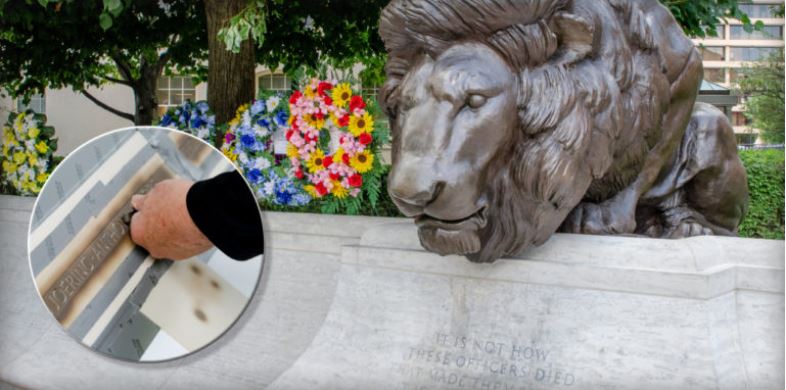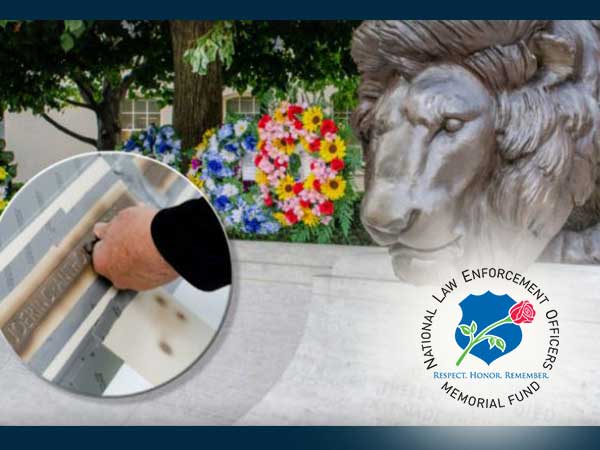Article from National Law Enforcement Officers Memorial Fund Newsroom
Researchers at the National Law Enforcement Officers Memorial follow a stringent and emotional process to vet names of the fallen.
Peeling back layers, overturning proverbial stones, unearthing nuggets of information that are sometimes nearly impossible to find. The process that leads to fallen officers being honored by the National Law Enforcement Officers Memorial is not simply an investigative skill that can be learned. It’s a gift.
Fortunately, the Memorial Research department is enriched by two such gifted individuals, Carolie Heyliger and Vanissa Varnado. Heyliger, who researches historic cases, joined the department 21 years ago; Varnado, a former probation officer who researches recent cases, has worked in the specialized area since 2016. These two extraordinary individuals take on hundreds of cases each year, and follow them through an arduous process, gathering pertinent information on fallen officers from a variety of sources. As a result of their hard work, about 300 names are approved and added to the wall each year.
“Once a case is identified, we wait an appropriate time, send a condolence letter, then the task force identifies the best point of contact,” said Varnado.
Heyliger sometimes has historians help her run down information, but one unexpected source that helps greatly with historical cases is online genealogy services. These sites have been very helpful in finding survivors.
“Often, the fallen officer’s department can’t find family for historic cases, so sadly, there’s no one to notify,” explained Heyliger. “It’s important to find people to notify that their family member is being honored ahead of time, because once a name is read at the annual Candlelight Vigil ceremony, they’re never read again. The family has missed their chance to share in the experience.”
With online genealogy services, the department gets a response about half the time. “Sometimes the response is enthusiastic, but sometimes too much time has passed, and they don’t really have a connection,” continued Heyliger. “What’s exciting are the times when a family first hears about the opportunity, and they are thrilled that great-grandpa’s name is on the wall and they end up attending the Candlelight Vigil.”

The Painstaking Process
There are many ways the organization learns of a possible line-of-duty death, from news stories to social media, and sometimes directly from someone close to the fallen. Quite frequently, one historical case is discovered while researching another.
Once an officer is identified as a possible honoree, a case file is opened and the extensive vetting process begins. The staff medical examiner takes all the medical files, sometimes hundreds of pages, and determines whether that evidence supports a line-of-duty death. If an officer dies of natural causes, such as a heart attack or stroke, additional medical documentation must be obtained to substantiate if the natural occurrence was preceded by a line-of-duty incident. COVID-19 has made the process even more difficult.
“With COVID-19, an officer can be taken out so quickly. Literally, in six weeks, they’re gone,” explained Varnado. “But we have to be diligent in our research. When did the officer become ill? Was there an outbreak at the department or facility, or among the staff? We need contact-tracing information, like the history of direct exposure. It can be difficult, but we are determined, and we get the information in the end.”
Emotionally Taxing, Yet Thoroughly Rewarding
Those left behind suffer the most, and it’s Heyliger and Varnado who are tasked with taking surviving family members through the process to honor their loved ones. Varnado feels that her past career as a probation officer has helped her deal with such difficult situations.
“Being on the research team requires skills in psychology, therapy, investigation, reporting,” said Varnado. “I have a background in sociology and criminal justice, and I think people find me easy to talk to. I try to always have a calming demeanor, to be a good listener.”
Heyliger often experiences similar difficult situations. “With historical cases, when I have to contact family, it’s like walking on eggshells,” explained Heyliger. “You don’t know if they had a relationship – good or bad – with their grandfather. You’re not sure what to expect. Some family members see this as an honor; for others, it’s still very raw, even though it may have happened years ago. There’s really no amount of time to get over the loss,” continued Heyliger. “They need to talk. They need someone to listen.”
According to Varnado, “Any call with a primary survivor is difficult and can trigger an emotional response. They often share stories of their loved ones, giving me a glimpse into their lives and the difficulty of the loss.”
Once a case file is complete, the research department sends it to the Memorial Names Committee, a group of National Law Enforcement Officers Memorial Fund board members who have voting authority to approve or deny a case. “We sometimes get questionable cases, where we present the information, but don’t know how the Names Committee is going to vote. So, we are rooting for someone to be honored,” Varnado explained.
The process, though emotionally taxing, has its rewards. “Getting an officer’s name on the wall is very satisfying,” said Heyliger.
“I think, personally, it’s great that what we do helps bring the family a sense that their loved one’s career meant something,” Varnado concluded. “They can always come back, view the name, tell the next generation about it, and the honor continues.”
The satisfaction of knowing they have helped immortalize someone’s beloved family member is the greatest gift these accomplished researchers can offer.
“It may sound trite,” said Heyliger. “But it truly is a gift that keeps on giving … for generations to come.”

